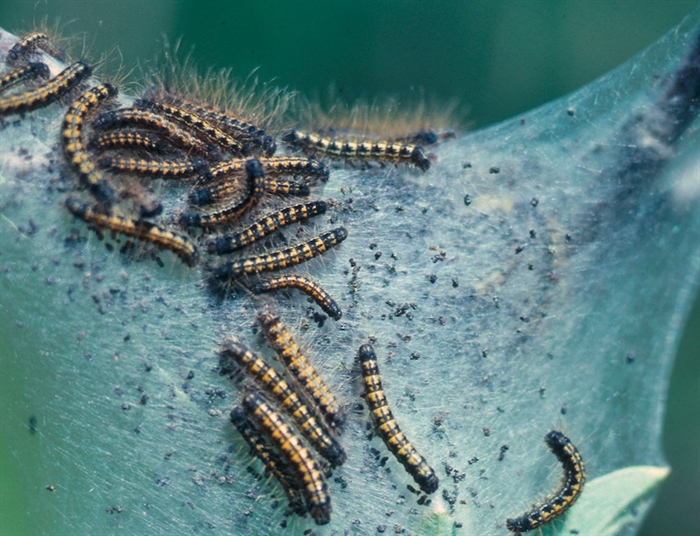
Western tent caterpillar
Image Credit: SUBMITTED/Natural Resources Canada – Canadian Forest Service
June 21, 2018 - 6:30 PM
EDITOR'S NOTE: Aug. 2, 2018
New information now strongly indicates it was in fact an outbreak of the Western yellowstriped armyworm, and not the Western tent caterpillar that was seen in large numbers during May and June. We apologize for the misidentification.
ORIGINAL STORY:
NORTH OKANAGAN - Noticed a lot of caterpillars this year? You’re not alone.
In some parts of the North Okanagan, thousands of caterpillars were seen blanketing roads and dropping from trees in late May and early June.
Dr. Amanda Roe, with the Canadian Forest Service, says it’s likely the western tent caterpillar on the high end of its roughly ten year cycle.
“They’re always around, but they go through cycles,” Roe says. “Most of the time people don’t even notice them because they’re hidden away in a host plant. It’s only when those numbers get really high that people start to notice them. We call this the cycle’s outbreak.”
An “outbreak” is actually happening across Canada right now, with several provinces experiencing high numbers of their respective tent caterpillar (in Ontario, for example, it’s the forest tent caterpillar.)
“People will usually remember as a kid a time when the caterpillars were really bad and then it goes away and you don’t see it again until you’re an adult,” Roe says.
When you see hoards of caterpillars migrating across roads, that’s when the critters are in their “wandering” stage, Roe says. During this phase, the caterpillars are looking to fill up on food before building their cocoons.
While gardeners and orchardists may not appreciate the bugs, Roe says they rarely kill trees and actually have an important role to play in the environment.
“It’s a natural disturbance, just like fire is a natural disturbance. The forests are used to having these different biological cycles. What caterpillars do help with is, they eat all the leaves and then they poop, and the poop falls to the ground, and that provides an injection of nitrogen into the forest floor that normally isn’t coming because it’s normally tied up in the leaves,” she says.
It also brings light to the forest floor because the foliage is gone, she says. The caterpillars themselves are also food for birds and other animals.
Roe says you shouldn’t worry much about caterpillars on your trees, just make sure your plants have lots of water and are otherwise healthy.
“When people finally start to notice them, you’re almost at the end of the caterpillar stage so spending a lot of money on pesticides, well, the damage that’s going to be done is already done,” Roe says. “Prevent other stresses, like drought stress, and the tree will have the resources to re-flush its leaves and recoup.”
She says tent caterpillars are actually fascinating social creatures.
“People might notice big white cotton candy looking nests in trees or shrubs around their property. Those are the tents. When they (caterpillars) are young, they live as a family group inside that tent,” Roe says. “That’s a family that makes a tent and goes and sleeps in it overnight. They go out and eat and come back to the tent. The social behaviour of tent caterpillars are very interesting. They’re very communal and have well developed social interactions.”
When they emerge from their cocoons around July, they become moths, not butterflies, Roe says.
“They don’t eat. They have no way of taking in food or water so they have a short adult life span. They may only be an adult moth for a day or two. Most of their life is as a caterpillar. When they become a moth, that’s their mating phase.”
She says Canadian researchers are examining tent caterpillar cycles to try to predict when outbreaks will occur in the future.
To contact a reporter for this story, email Charlotte Helston or call 250-309-5230 or email the editor. You can also submit photos, videos or news tips to the newsroom and be entered to win a monthly prize draw.
We welcome your comments and opinions on our stories but play nice. We won't censor or delete comments unless they contain off-topic statements or links, unnecessary vulgarity, false facts, spam or obviously fake profiles. If you have any concerns about what you see in comments, email the editor in the link above.
News from © iNFOnews, 2018